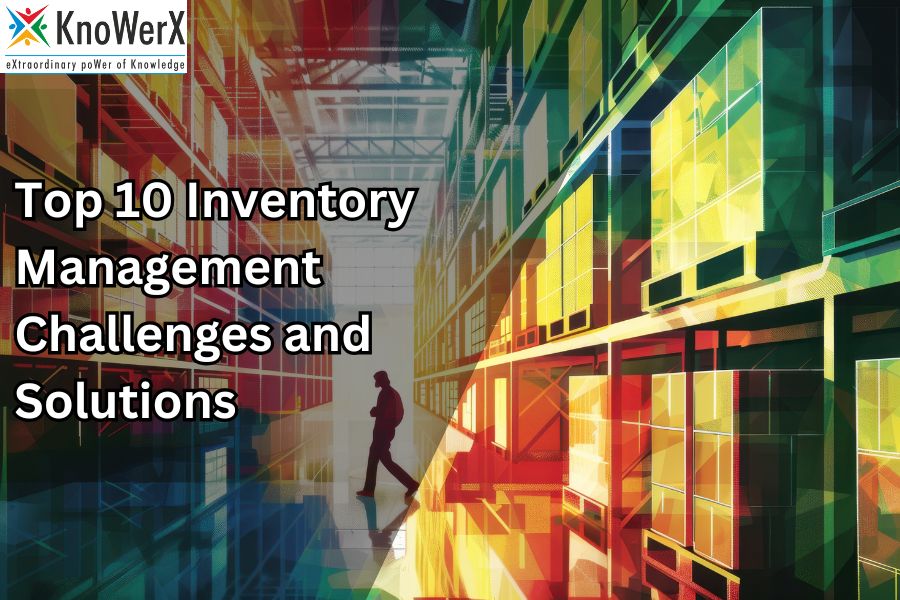Uncover the 10 Inventory Management Challenges and Solutions
Effective inventory management is a critical component of any successful business. Whether you’re managing a small operation or overseeing a large, global supply chain, inventory management challenges can significantly impact your profitability and efficiency. This article explores the top 10 inventory management challenges and provides actionable solutions to overcome them. Addressing these common pain points can optimize your supply chain, reduce costs, and improve overall operational performance.

Inaccurate Inventory Tracking
One of the most common inventory management challenges is inaccurate inventory tracking. Manual data entry errors, outdated systems, or inadequate tracking methods often lead to discrepancies between actual stock levels and what is recorded in inventory systems. This misalignment can result in stockouts, overstocking, or poor customer service.
Solution:
To solve this, businesses should implement advanced inventory management software that supports real-time tracking. Automated systems use barcode scanning, RFID (radio-frequency identification), or IoT (Internet of Things) devices to minimize human error and ensure that inventory records are always up to date. Such systems also provide accurate data, allowing for better decision-making and resource allocation.
Overstocking and Understocking
Striking the right balance between overstocking and understocking is one of the key inventory management challenges. Overstocking ties up capital in excess inventory, while understocking leads to missed sales opportunities and unhappy customers.
Solution:
Using demand forecasting tools and Just-In-Time (JIT) inventory strategies can help manage this balance effectively. Demand forecasting, powered by data analytics, enables businesses to predict future sales trends more accurately. JIT inventory strategies ensure that inventory is replenished only when necessary, minimizing excess stock while preventing stockouts.
Inefficient Supply Chain Visibility
Limited visibility across the supply chain is another significant challenge. Without real-time data on inventory levels, shipments, and supplier performance, businesses struggle to make informed decisions, which can result in delays, excess costs, and disruptions.
Solution:
Adopting integrated supply chain management systems that offer end-to-end visibility is essential. These systems connect various elements of the supply chain, providing real-time updates on inventory, shipments, and supplier performance. Improved visibility helps businesses respond proactively to disruptions, streamline communication, and optimize inventory management.
High Holding Costs
The cost of holding inventory can quickly add up, particularly when inventory sits idle in storage for extended periods. Expenses related to storage, insurance, obsolescence, and depreciation can drain resources if not properly managed.
Solution:
To reduce holding costs, businesses should optimize their warehouse layout to ensure efficient storage and easy access to high-turnover items. Additionally, improving inventory turnover rates by adjusting order quantities and frequency can help reduce excess stock. Negotiating better terms with suppliers, such as lower minimum order quantities or more frequent deliveries, can also reduce holding costs.
Poor Demand Forecasting
Inaccurate demand forecasting is one of the leading inventory management challenges. If forecasts are too high, businesses end up with excess inventory that may become obsolete. If forecasts are too low, stockouts occur, resulting in missed sales and dissatisfied customers.
Solution:
To improve demand forecasting, businesses should use data analytics and machine learning algorithms that analyse historical sales data, market trends, and seasonality. These tools provide more accurate forecasts, allowing companies to align their inventory levels with actual demand. Accurate forecasting minimizes excess inventory and reduces the risk of stockouts.
Ineffective Inventory Categorization

Inventory categorization is crucial for prioritizing the management of different items. Without an effective system in place, businesses may find it challenging to focus on high-priority inventory, leading to mismanagement of valuable resources.
Solution:
ABC analysis is a proven method for categorizing inventory based on its importance. Category A consists of high-value items with low sales frequency, Category B includes moderate-value items with moderate frequency, and Category C covers low-value items with high frequency. Tailoring inventory management strategies for each category ensures that resources are allocated efficiently, preventing overstocking and understocking.
Limited Integration with Suppliers and Distributors
A lack of integration with suppliers and distributors can cause significant disruptions in the supply chain. Miscommunications, delayed shipments, and inefficient order processing are common issues when systems aren’t well connected.
Solution:
Seamless integration with suppliers and distributors is vital for smooth operations. Implementing systems with API integration and collaborative platforms enables better communication, faster order processing, and real-time tracking of shipments. This integration ensures that inventory is replenished as needed, reducing lead times and improving customer satisfaction.
Lack of Real-Time Data Access
Without real-time access to inventory data, businesses struggle to make timely decisions, leading to inefficiencies in managing stock levels, fulfilling orders, and reacting to supply chain disruptions.
Solution:
Cloud-based inventory management systems provide real-time access to inventory data from anywhere, allowing businesses to make informed decisions quickly. With this capability, companies can respond immediately to changes in demand, shipment delays, or stockouts, improving overall inventory management and customer service.
Managing Returns and Reverse Logistics
Managing returns is often one of the more overlooked inventory management challenges. Without a proper system in place, businesses can lose track of returned items, leading to inefficiencies, lost revenue, and unhappy customers.
Solution:
A well-developed reverse logistics process is crucial for handling returns efficiently. Specialized software that tracks returns, processes refunds or exchanges and manages to restock ensures that returned items are quickly reintegrated into inventory. A streamlined returns process also helps maintain customer satisfaction and reduces the risk of lost inventory.
Compliance and Regulatory Issues
Adhering to regulatory requirements and managing compliance issues related to inventory management can be complex, particularly for businesses operating in multiple regions with different rules and standards.
Solution:
To ensure compliance, businesses should stay updated with regulatory changes and use compliance management tools integrated into their inventory systems. These tools help track relevant regulations, automate reporting, and ensure that all processes are aligned with legal requirements, reducing the risk of fines or disruptions.
FAQs: Frequently Asked Questions
What are the most common inventory management challenges?
The most common inventory management challenges include inaccurate inventory tracking, overstocking, understocking, high holding costs, poor demand forecasting, and limited supply chain visibility.
How can businesses overcome inventory management issues?
Businesses can use advanced inventory management software, demand forecasting tools, and real-time data systems to overcome challenges like inaccurate tracking, overstocking, and poor visibility.
What is the role of demand forecasting in inventory management?
Demand forecasting helps businesses predict future sales trends accurately, allowing them to balance inventory levels effectively, avoid stockouts, and reduce excess inventory.
How can supply chain visibility improve inventory management?
Supply chain visibility provides real-time updates on inventory, shipments, and supplier performance, enabling businesses to make informed decisions and streamline operations.
How can KnoWerX help with inventory management?
KnoWerX offers the Certified Inventory Management Officer (CIMO) course, which equips professionals with the skills needed to tackle inventory management challenges, optimize processes, and enhance business performance.
End Notes

At KnoWerX, we understand that effective inventory management is crucial for businesses to thrive in today’s highly competitive market. By addressing the top 10 inventory management challenges and applying the right solutions, organizations can significantly improve their supply chain efficiency, reduce costs, and boost overall performance. Whether it’s utilizing advanced software, improving demand forecasting, or implementing integrated supply chain systems, overcoming these challenges is key to achieving a smoother and more profitable operation.
Our Certified Inventory Management Officer (CIMO) course is specifically designed to tackle these challenges. Through this certification, you’ll gain the expertise to optimize your inventory processes, adopt cutting-edge strategies, and enhance your business’s overall efficiency. Partner with KnoWerX to unlock the skills and knowledge required to excel in inventory management, ensuring your organization stays ahead in the ever-evolving supply chain landscape.
Image Reference : Freepik
Disclaimer: All trademarks, logos, and brand names are the property of their respective owners. All company, product, and service names used in this website are for identification purposes only. Use of these names, trademarks, and brands does not imply endorsement.



